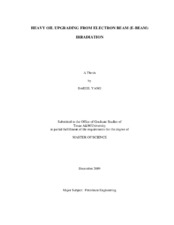| dc.description.abstract | Society's growing demands for energy results in rapid increase in oil consumption and motivates us to make unconventional resources conventional resources. There are enormous amounts of heavy oil reserves in the world but the lack of cost effective technologies either for extraction, transportation, or refinery upgrading hinders the development of heavy oil reserves.
One of the critical problems with heavy oil and bitumen is that they require large amounts of thermal energy and expensive catalysts to upgrade. This thesis demonstrates that electron beam (E-Beam) heavy oil upgrading, which uses unique features of E-Beam irradiation, may be used to improve conventional heavy oil upgrading. E-Beam processing lowers the thermal energy requirements and could sharply reduce the investment in catalysts. The design of the facilities can be simpler and will contribute to lowering the costs of transporting and processing heavy oil and bitumen.
E-Beam technology uses the high kinetic energy of fast electrons, which not only transfer their energy but also interact with hydrocarbons to break the heavy molecules with lower thermal energy.
In this work, we conducted three major stages to evaluate the applicability of E-Beam for heavy oil upgrading. First, we conducted laboratory experiments to investigate the effects of E-Beam on hydrocarbons. To do so, we used a Van de Graff accelerator, which generates the high kinetic energy of electrons, and a laboratory scale apparatus to investigate extensively how radiation effects hydrocarbons. Second, we studied the energy transfer mechanism of E-Beam upgrading to optimize the process. Third, we conducted a preliminary economic analysis based on energy consumption and compared the economics of E-Beam upgrading with conventional upgrading.
The results of our study are very encouraging. From the experiments we found that E-Beam effect on hydrocarbon is significant. We used less thermal energy for distillation of n-hexadecane (n-C16) and naphtha with E-Beam. The results of experiments with asphaltene indicate that E-Beam enhances the decomposition of heavy hydrocarbon molecules and improves the quality of upgraded hydrocarbon. From the study of energy transfer mechanism, we estimated heat loss, fluid movement, and radiation energy distribution during the reaction. The results of our economic evaluation show that E-Beam upgrading appears to be economically feasible in petroleum industry applications.
These results indicate significant potential for the application of E-Beam technology throughout the petroleum industry, particularly near production facilities, transportation pipelines, and refining industry. | en |


